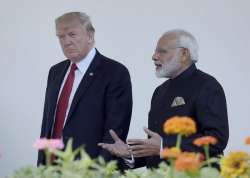US GSP withdrawal: New markets, subsidy to help India contain trade deficit
New export markets, financial support and lower crude oil prices are likely to offset the impact on trade deficit caused by US ending preferential treatment to various goods supplied from India.

New export markets, financial support and lower crude oil prices are likely to offset the impact on trade deficit caused by US ending preferential treatment to various goods supplied from India.
The Trump administration had last week announced withdrawal of generalized system of preferences or GSP benefits from June 5, 2019. These non-reciprocal and non-discriminatory export benefits are extended by developed countries to developing countries.
Industry observers cite the benefit of only around $200 million as insignificant to cause major worry. However, the move could not have come at a worse time for India's economy which faces a consumption slowdown, slower growth and contraction in core industrial production.
Latest figures show that the country's trade deficit during April widened to $15.33 billion as against the deficit of $13.72 billion during the corresponding month of last year.
"The withdrawal of GSP benefits to exports will have a one-time impact which will be reflected in the overall trade deficit," Sunil Kumar Sinha, Director, Public Finance and Principal Economist India Ratings and Research (Fitch Group), told IANS.
"However, rather than relying upon any export subsidy scheme, exporters should pursue newer markets such as South America and Africa. We should also become globally competitive in terms of manufacturing and cost structures."
However, Trade Promotion Council of India's Chairman Mohit Singla said: "The loss is minimal. Besides, the goods exported to the US such as pharmaceuticals, natural or cultured pearls and machinery and mechanical appliances, among others, are difficult to replace due to India's competitiveness in these products."
"So, India may not be affected significantly and it can enhance its exports in other countries to cover the minor loss."
India's top GSP exports to the United States in 2018 included motor vehicle parts, ferro alloys, precious metal jewellery, building stone, insulated cables and wires.
Overall, out of $36 billion exports to the US by India, $5.7 billion worth of exports from India will be impacted.
India's trade surplus for merchandise goods with US is almost $18-19 billion.
On the other hand, Federation of Indian Export Organisations' President Ganesh Kumar Gupta pointed out that exporters of products having GSP benefits of 3 per cent or more will find it difficult to absorb the loss.
According to Gupta, most affected sectors will be imitation jewellery, leather articles other than footwear, pharmaceuticals and surgical products and chemical and plastics.
He said government should provide supports to products where GSP loss has been significant so that "the market is not lost".
Earlier in March, the US had given a 60-day withdrawal notice to India on the GSP benefits extended by it.
The US commenced a review in April 2018 on India's GSP benefits, while both the countries were discussing various trade issues of bilateral interest.
Also Read| US advocacy group seeks India Trade Representative under PMO